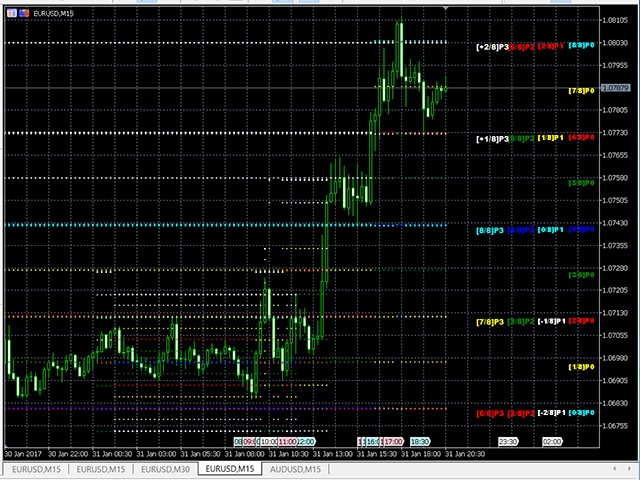An indicator that calculates and displays the Murray levels on the chart.
This version for MT5 is similar to the MT4 version:
It allows you to build up to 4 octaves on one chart, inclusive, using data from different timeframes, which allows you to estimate the ratio of trends and investment horizons of different orders. The difference from the MT4 version is that it automatically selects the search algorithm for the basis for calculating the range.
The value of the levels can be obtained by calling the user-defined iCustom()function;
There are 13 levels in each octave. There are 52 indicator buffers in total in 4 octaves.
- 0 the buffer corresponds to the value of the level 2/8 octave with the index P0
- …
- 12 the buffer corresponds to the value of the -2/8 octave level with the index P0
- …
- 13 the buffer corresponds to the value of the level 2/8 octave with the index P1
- …
- 25 the buffer corresponds to the value of the -2/8 octave level with the index P1
- …
- etc….
- 52 the buffer corresponds to the value of the -2/8 octave level with the index P3
Displays its readings on historical data. The free version, freely distributed with variations by different authors, draws readings calculated on the current bar on the history, which does not allow it to be used for correct analysis of price movements in the past and makes it difficult to determine the likely direction of price movement in the current price range.
[spoiler title=”Read More…”]
There are versions that show their values according to history, the correctness of which is unknown to me.
To facilitate the operation of the indicator, the number of bars in the history is limited – the BarsCNT parameter is 150 bars by default.
To study the behavior of the indicator by history in manual mode, the shift parameter is introducedStepBack, which allows you to build the specified number of indicator readings on the history not only from the current bar.
Attention! In this version of the indicator, the selection of ranges for constructing octaves has been improved.
Attention! In this version of the indicator, the selection of ranges for constructing octaves has been improved.
The indicator is configured by default for intraday trading with the construction of levels according to the hourly range, which allows it to be used correctly for all intra-hourly ranges. If it is necessary to use the indicator on the higher timeframes, the timeframe of the current chart will be automatically selected, or you need to manually set the desired timeframe for constructing octave ranges that is larger than the timeframe of the current chart.
Change the default settings only if you are confident in your actions. For most trading strategies, the default parameters will be optimal.
Change the default settings only if you are confident in your actions. For most trading strategies, the default parameters will be optimal.
[/spoiler]





